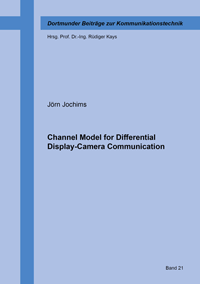
Shop : Details
Shop
Details
59,80 €ISBN 978-3-8440-9381-0Softcover224 pages78 figures294 g21 x 14,8 cmEnglishThesis
February 2024
Jörn Jochims
Channel Model for Differential Display-Camera Communication
Display-Camera Communication (DCC) is a special type of Visible Light Communication that utilizes digital displays as transmitters and cameras as receivers, enabling high rate optical free-space communication. For DCC systems it can be differentiated between non-hidden approaches, for which the data presented on the transmitting display is visible to observers, and hidden approaches, implementing a data transmission that is imperceptible to the human eye.
The DCC channel suffers from various noise and interference effects that must be considered when describing the channel: Photon noise and dark noise in the receiver camera decrease the achievable SNR. Also, the timings of transmitting display and receiving camera are usually not synchronized, possibly leading to interference between different presented frames of the display in the captured images of the receiver camera. Furthermore, the optical system of the camera introduces blur, which together with the random alignment between display and camera inevitably leads to spatial interference in the data blocks of the overlaid data patterns. Lastly, when overlaying data in multiple color channels simultaneously, crosstalk between color channels can be observed.
A novel channel model for the differential DCC channel with imperceptible data transmission, for which data is overlaid to arbitrary image content, is presented in this work. The model incorporates the noise and interference effects mentioned above giving insights on the achievable channel capacity based on the underlying image content and the display and camera hardware used.
The DCC channel suffers from various noise and interference effects that must be considered when describing the channel: Photon noise and dark noise in the receiver camera decrease the achievable SNR. Also, the timings of transmitting display and receiving camera are usually not synchronized, possibly leading to interference between different presented frames of the display in the captured images of the receiver camera. Furthermore, the optical system of the camera introduces blur, which together with the random alignment between display and camera inevitably leads to spatial interference in the data blocks of the overlaid data patterns. Lastly, when overlaying data in multiple color channels simultaneously, crosstalk between color channels can be observed.
A novel channel model for the differential DCC channel with imperceptible data transmission, for which data is overlaid to arbitrary image content, is presented in this work. The model incorporates the noise and interference effects mentioned above giving insights on the achievable channel capacity based on the underlying image content and the display and camera hardware used.
Keywords: Visible Light Communication; Display-Camera Communication; Channel Model
Dortmunder Beiträge zur Kommunikationstechnik
Edited by Prof. Dr.-Ing. Rüdiger Kays, Dortmund
Volume 21
Available online documents for this title
You need Adobe Reader, to view these files. Here you will find a little help and information for downloading the PDF files.
Please note that the online documents cannot be printed or edited.
Please also see further information at: Help and Information.
Please also see further information at: Help and Information.
| Document |  | Document | ||
| Type |  | |||
| Costs |  | 44,85 € | ||
| Action |  | Purchase in obligation and download the file | ||
| Document |  | Table of contents | ||
| Type |  | |||
| Costs |  | free | ||
| Action |  | Download the file | ||
User settings for registered online customers (online documents)
You can change your address details here and access documents you have already ordered.
User
Not logged in
Export of bibliographic data
Shaker Verlag GmbH
Am Langen Graben 15a
52353 Düren
Germany
Am Langen Graben 15a
52353 Düren
Germany
Mon. - Thurs. 8:00 a.m. to 4:00 p.m.
Fri. 8:00 a.m. to 3:00 p.m.
Fri. 8:00 a.m. to 3:00 p.m.
Contact us. We will be happy to help you.



